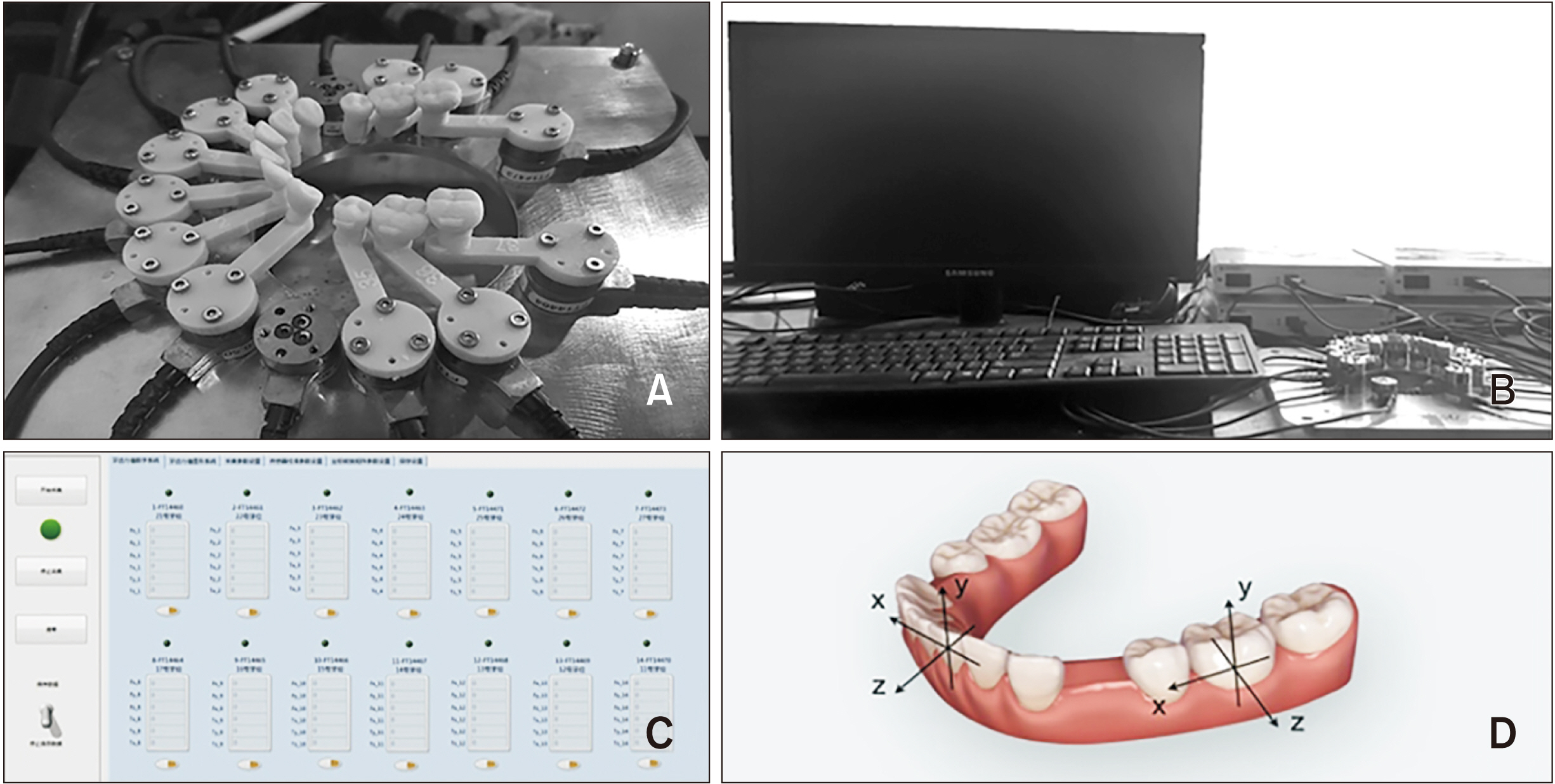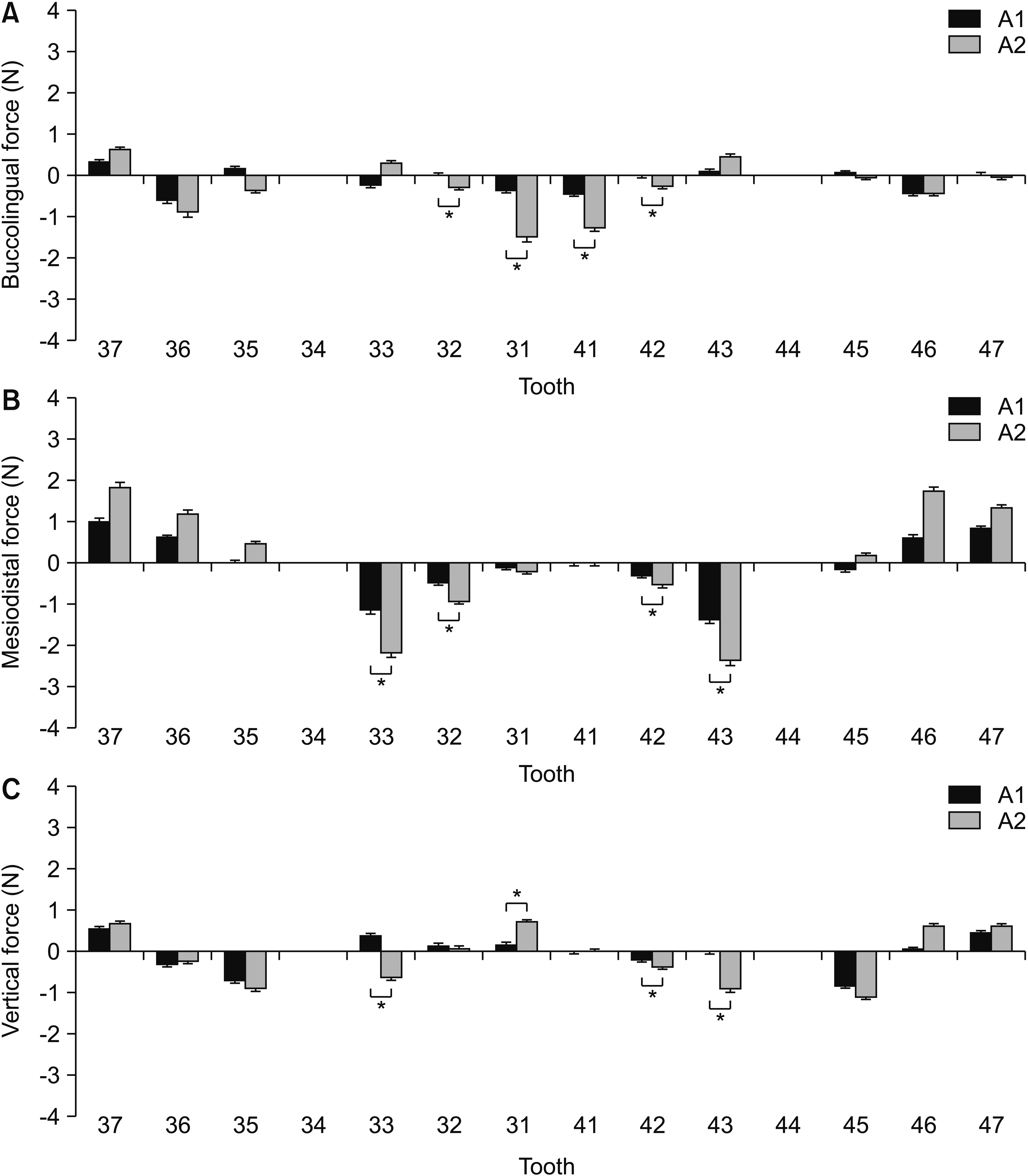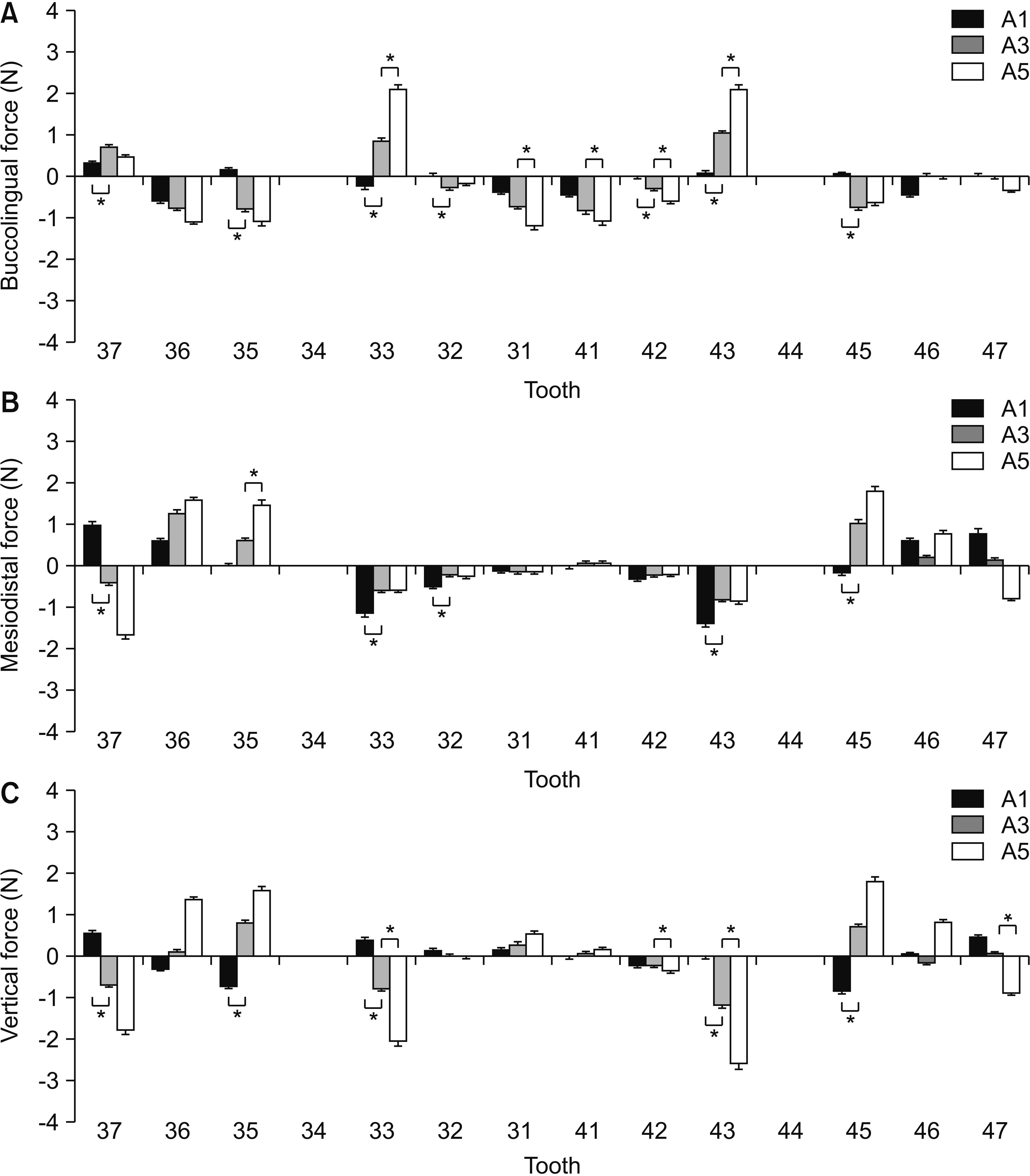Korean J Orthod.
2021 Jan;51(1):32-42. 10.4041/kjod.2021.51.1.32.
Force changes associated with differential activation of en-masse retraction and/or intrusion with clear aligners
- Affiliations
-
- 1Department of Orthodontics, Peking University School and Hospital of Stomatology, Beijing, China
- KMID: 2510616
- DOI: http://doi.org/10.4041/kjod.2021.51.1.32
Abstract
Objective
To investigate the three-dimensional forces created by clear aligners on mandibular teeth during differential activation with en-masse retraction and/or intrusion in vitro.
Methods
Six sets of clear aligners were designed for differential en-masse retraction and/or intrusion procedures in a first premolar extraction model. Group A0 was a control group with no activation. Groups A1–5 underwent different degrees of retractions and/or intrusions. Each group consisted of 10 aligners. Aligner forces were measured on a multi-axis force/ torque transducer measurement system in real-time.
Results
In the en-masse retraction groups (A1 and A2), lingual and extrusive forces were observed on the incisors; the canines mainly received distal forces; intrusive forces were seen on the second premolars; and the molars received mesial forces. In the enmasse retraction and intrusion groups (A3, A4, and A5), incisors also received lingual and extrusive forces; canines received distal and intrusive forces; mesial and extrusive forces were seen on the second premolars; and the second molars received distal and intrusive forces. The vertical forces on the incisors did not differ significantly among groups A1, A3, and A5. However, the vertical forces on the second premolars reversed from intrusion in group A1 to extrusion in groups A3 and A5.
Conclusions
With clear aligners, the “bowing effect” is seen during en-masse anterior teeth retraction and can be partially relieved by performing en-masse retraction accompanied by anterior teeth intrusion. Vertical control of incisors remained unsolved during en-masse retraction, even when intrusive activation was added to the anterior teeth.
Figure
Reference
-
1. Turpin DL. 2005; Clinical trials needed to answer questions about Invisalign. Am J Orthod Dentofacial Orthop. 127:157–8. DOI: 10.1016/j.ajodo.2004.12.009. PMID: 15750531.2. Shin K. 2017; The Invisalign appliance could be an effective modality for treating overbite malocclusions within a mild to moderate range. J Evid Based Dent Pract. 17:278–80. DOI: 10.1016/j.jebdp.2017.06.010. PMID: 28865828.3. Bowman SJ, Celenza F, Sparaga J, Papadopoulos MA, Ojima K, Lin JC. 2015; Creative adjuncts for clear aligners, part 2: intrusion, rotation, and extrusion. J Clin Orthod. 49:162–72. PMID: 26104954.4. Khosravi R, Cohanim B, Hujoel P, Daher S, Neal M, Liu W, et al. 2017; Management of overbite with the Invisalign appliance. Am J Orthod Dentofacial Orthop. 151:691–9.e2. DOI: 10.1016/j.ajodo.2016.09.022. PMID: 28364892.5. Bowman SJ, Celenza F, Sparaga J, Papadopoulos MA, Ojima K, Lin JC. 2015; Creative adjuncts for clear aligners, part 1: class II treatment. J Clin Orthod. 49:83–94. PMID: 26106819.6. Houle JP, Piedade L, Todescan R Jr, Pinheiro FH. 2017; The predictability of transverse changes with Invisalign. Angle Orthod. 87:19–24. DOI: 10.2319/122115-875.1. PMID: 27304231.7. Bowman SJ, Celenza F, Sparaga J, Papadopoulos MA, Ojima K, Lin JC. 2015; Creative adjuncts for clear aligners, part 3: extraction and interdisciplinary treatment. J Clin Orthod. 49:249–62. PMID: 26105066.8. Womack WR. 2006; Four-premolar extraction treatment with Invisalign. J Clin Orthod. 40:493–500. PMID: 16963822.9. Baldwin DK, King G, Ramsay DS, Huang G, Bollen AM. 2008; Activation time and material stiffness of sequential removable orthodontic appliances. Part 3: premolar extraction patients. Am J Orthod Dentofacial Orthop. 133:837–45. DOI: 10.1016/j.ajodo.2006.06.025. PMID: 18538247.10. Giancotti A, Greco M, Mampieri G. 2006; Extraction treatment using Invisalign Technique. Prog Orthod. 7:32–43. PMID: 16552454.11. Ojima K, Dan C, Nishiyama R, Ohtsuka S, Schupp W. 2014; Accelerated extraction treatment with Invisalign. J Clin Orthod. 48:487–99. PMID: 25226041.12. Liu D, Yan B, Lei F, Li J, Wang X, Rong Q, et al. 2019; Different sliding mechanics in space closure of lingual orthodontics: a translational study by three-dimensional finite element method. Am J Transl Res. 11:120–30. PMID: 30787973. PMCID: PMC6357325.13. Hahn W, Dathe H, Fialka-Fricke J, Fricke-Zech S, Zapf A, Kubein-Meesenburg D, et al. 2009; Influence of thermoplastic appliance thickness on the magnitude of force delivered to a maxillary central incisor during tipping. Am J Orthod Dentofacial Orthop. 136:12.e1–7. discussion 12–3. DOI: 10.1016/j.ajodo.2008.12.015. PMID: 19577136.14. Hahn W, Zapf A, Dathe H, Fialka-Fricke J, Fricke-Zech S, Gruber R, et al. 2010; Torquing an upper central incisor with aligners--acting forces and biomechanical principles. Eur J Orthod. 32:607–13. DOI: 10.1093/ejo/cjq007. PMID: 20462912.15. Kohda N, Iijima M, Muguruma T, Brantley WA, Ahluwalia KS, Mizoguchi I. 2013; Effects of mechanical properties of thermoplastic materials on the initial force of thermoplastic appliances. Angle Orthod. 83:476–83. DOI: 10.2319/052512-432.1. PMID: 23035832.16. Simon M, Keilig L, Schwarze J, Jung BA, Bourauel C. 2014; Forces and moments generated by removable thermoplastic aligners: incisor torque, premolar derotation, and molar distalization. Am J Orthod Dentofacial Orthop. 145:728–36. DOI: 10.1016/j.ajodo.2014.03.015. PMID: 24880843.17. Li X, Ren C, Wang Z, Zhao P, Wang H, Bai Y. 2016; Changes in force associated with the amount of aligner activation and lingual bodily movement of the maxillary central incisor. Korean J Orthod. 46:65–72. DOI: 10.4041/kjod.2016.46.2.65. PMID: 27019820. PMCID: PMC4807150.18. Liu Y, Hu W. 2018; Force changes associated with different intrusion strategies for deep-bite correction by clear aligners. Angle Orthod. 88:771–8. DOI: 10.2319/121717-864.1. PMID: 30035613.19. Krieger E, Seiferth J, Saric I, Jung BA, Wehrbein H. 2011; Accuracy of invisalign® treatments in the anterior tooth region. First results. J Orofac Orthop. 72:141–9. DOI: 10.1007/s00056-011-0017-4. PMID: 21503854.20. Gu J, Tang JS, Skulski B, Fields HW Jr, Beck FM, Firestone AR, et al. 2017; Evaluation of Invisalign treatment effectiveness and efficiency compared with conventional fixed appliances using the Peer Assessment Rating index. Am J Orthod Dentofacial Orthop. 151:259–66. DOI: 10.1016/j.ajodo.2016.06.041. PMID: 28153154.21. Kravitz ND, Kusnoto B, BeGole E, Obrez A, Agran B. 2009; How well does Invisalign work? A prospective clinical study evaluating the efficacy of tooth movement with Invisalign. Am J Orthod Dentofacial Orthop. 135:27–35. DOI: 10.1016/j.ajodo.2007.05.018. PMID: 19121497.22. Li W, Wang S, Zhang Y. 2014; The effectiveness of the Invisalign appliance in extraction cases using the the ABO model grading system: a multicenter randomized controlled trial. Int J Clin Exp Med. 8:8276–82. PMID: 26221410. PMCID: PMC4509355.23. Bollen AM, Huang G, King G, Hujoel P, Ma T. 2003; Activation time and material stiffness of sequential removable orthodontic appliances. Part 1: ability to complete treatment. Am J Orthod Dentofacial Orthop. 124:496–501. DOI: 10.1016/S0889-5406(03)00576-6. PMID: 14614415.24. Caputo AA, Chaconas SJ, Hayashi RK. 1974; Photoelastic visualization of orthodontic forces during canine retraction. Am J Orthod. 65:250–9. DOI: 10.1016/S0002-9416(74)90330-3. PMID: 4521359.25. Knop L, Gandini LG Jr, Shintcovsk RL, Gandini MR. 2015; Scientific use of the finite element method in orthodontics. Dental Press J Orthod. 20:119–25. DOI: 10.1590/2176-9451.20.2.119-125.sar. PMID: 25992996. PMCID: PMC4445234.26. Barbagallo LJ, Shen G, Jones AS, Swain MV, Petocz P, Darendeliler MA. 2008; A novel pressure film approach for determining the force imparted by clear removable thermoplastic appliances. Ann Biomed Eng. 36:335–41. DOI: 10.1007/s10439-007-9424-5. PMID: 18085439.27. Vardimon AD, Robbins D, Brosh T. 2010; In-vivo von Mises strains during Invisalign treatment. Am J Orthod Dentofacial Orthop. 138:399–409. DOI: 10.1016/j.ajodo.2008.11.027. PMID: 20889044.28. Badawi H, Major P. 2010; Three-dimensional orthodontic force measurements. Am J Orthod Dentofacial Orthop. 137:299–300. DOI: 10.1016/j.ajodo.2010.01.006. PMID: 20197155.29. Ferguson JW. 1990; Lower incisor torque: the effects of rectangular archwires with a reverse curve of Spee. Br J Orthod. 17:311–5. DOI: 10.1179/bjo.17.4.311. PMID: 2285700.30. Pandis N, Polychronopoulou A, Sifakakis I, Makou M, Eliades T. 2010; Effects of levelling of the curve of Spee on the proclination of mandibular incisors and expansion of dental arches: a prospective clinical trial. Aust Orthod J. 26:61–5. PMID: 20575202.31. Clements KM, Bollen AM, Huang G, King G, Hujoel P, Ma T. 2003; Activation time and material stiffness of sequential removable orthodontic appliances. Part 2: Dental improvements. Am J Orthod Dentofacial Orthop. 124:502–8. DOI: 10.1016/S0889-5406(03)00577-8. PMID: 14614416.32. Jacobson A. 2000; Contemporary orthodontics, 3rd edition. Am J Orthod Dentofacial Orthop. 117:PA1. DOI: 10.1016/S0889-5406(00)70018-7.
- Full Text Links
- Actions
-
Cited
- CITED
-
- Close
- Share
- Similar articles
-
- Finite element analysis of the effects of different archwire forms and power arm positions on maxillary incisors in en masse retraction using fixed lingual orthodontic appliances
- Palatal en-masse retraction of segmented maxillary anterior teeth: A finite element study
- Type of tooth movement during en masse retraction of the maxillary anterior teeth using labial versus lingual biocreative therapy in adults: A randomized clinical trial
- A comparison of en masse retraction of six anterior teeth with separate canine retraction
- Force Assessment of Thermoformed and Direct-printed Aligners in a Lingual Bodily Movement of a Central Incisor Over Time: A 14-day In Vitro Study






